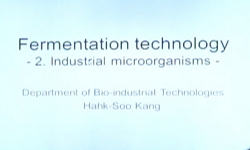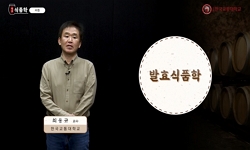오가피 추출액을 첨가하여 약주를 제조하고 발효 및 품질특성을 조사하였다. 오가피 추출물 첨가 발효주는 대조구와 전체적으로 비슷한 발효 특성을 보였다. pH는 모든 처리구에서 발효 3일 ...
http://chineseinput.net/에서 pinyin(병음)방식으로 중국어를 변환할 수 있습니다.
변환된 중국어를 복사하여 사용하시면 됩니다.
- 中文 을 입력하시려면 zhongwen을 입력하시고 space를누르시면됩니다.
- 北京 을 입력하시려면 beijing을 입력하시고 space를 누르시면 됩니다.
https://www.riss.kr/link?id=A76266541
- 저자
- 발행기관
- 학술지명
- 권호사항
-
발행연도
2008
-
작성언어
Korean
- 주제어
-
등재정보
KCI등재,SCOPUS
-
자료형태
학술저널
- 발행기관 URL
-
수록면
521-527(7쪽)
-
KCI 피인용횟수
15
- DOI식별코드
- 제공처
- 소장기관
-
0
상세조회 -
0
다운로드
부가정보
국문 초록 (Abstract)
오가피 추출액을 첨가하여 약주를 제조하고 발효 및 품질특성을 조사하였다. 오가피 추출물 첨가 발효주는 대조구와 전체적으로 비슷한 발효 특성을 보였다. pH는 모든 처리구에서 발효 3일 만에 급격히 떨어졌고 발효 6일 이후로는 4.0 내외로 변화가 없었으며, 산도는 오가피 추출물 첨가구와 대조구 차이가 거의 없었다. 당도와 환원당은 모든 시험구에서 발효초기에 감소하다가 후기에는 완만하게 감소하였다. 발효주의 알코올 함량은 발효초기에는 대조구가 오가피 추출물 첨가구보다 높았으나 발효 6일째 이후로는 오가피 추출물 첨가구의 함량이 높았으며, 발효 종료일까지 점차적으로 증가하는 경향을 보였다. pH, 산도, 환원당 및 알코올 함량이 발효 0~3일 사이에 급격히 변화하는 것으로 나타나 담금 후 0~3일에 발효가 가장 왕성하게 일어나는 것으로 사료되었다. 유기산으로는 acetic acid, lactic acid, oxalic acid, malic acid 및 succinic acid가 검출되었으며, 전체 유기산 함량은 acetic acid의 함량이 가장 많았다. 오가피의 지표 성분으로 알려져 있는 eleutheroside E와 chlorogenic acid는 2단 담금 후에는 두 유효성분의 함량 변화가 거의 없이 안정된 상태를 유지하였으며, 발효 종료일에는 발효주 중의 eleutheroside E 함량은 7.61±0.39 ㎍/mL이었고, chlorogenic acid 함량은 3.63±0.18 ㎍/mL이었다. Fusel oil 함량은 두 시험구에서 n-propyl alcohol, isobutyl alcohol 및 isoamyl alcohol 함량이 0.08±0.001~0.86±0.03 ㎎%로 적은 양이 검출되었다. 관능검사 결과 오가피 추출물 첨가구는 전체적으로 모든 항목에서 대조구와 유사한 관능평점을 나타내었다.
다국어 초록 (Multilingual Abstract)
Acanthopanacis cortex extracts added Yakju was manufactured and then fermentation and quality characteristics of Yakju were examined. Acanthopanacis cortex extracts added Yakju showed totally similar characteristics with the non-extract added Yakju of...
Acanthopanacis cortex extracts added Yakju was manufactured and then fermentation and quality characteristics of Yakju were examined. Acanthopanacis cortex extracts added Yakju showed totally similar characteristics with the non-extract added Yakju of control groups. The pH showed almost no change to pH 4.0 after 6 days of fermentation and it was decreased only once in only fermentation time of 3 days. The acidity of Acanthopanacis cortex extracts added group showed no difference to the control group. The sugar obrix and reducing sugar content showed decrease in all two groups in the initial fermentation stage; however, it showed slow decrease as the late fermentation stage. The Acanthopanacis cortex extracts added Yakju showed less alcohol content than the control group in the initial fermentation stage. However, after 6 days of fermentation, the Acanthopanacis cortex extracts added Yakju showed more alcohol contents and constant increase till the final fermentation day. The pH, acidity, reducing sugar and alcohol content showed rapid changes between fermentation days 0 through 3. Therefore, it means that the Acanthopanacis cortex extracts added Yakju fermentation actively takes place between the days 0 through 3. Organic acids detected in Yakju were acetic, lactic, oxalic, malic and succinic acids. The acetic acid was the highest among the total acid contents. Eleutheroside E and chlorogenic acid, known as the effective components of Acanthopanacis cortex, showed stable status without changes in component content till stage two fermentation. The contents of eleutheroside E and chlorogenic acid were 7.61±0.39 ㎍/mL and 3.63±0.18 ㎍/mL on the final fermentation day, respectively. The fusel oil was slightly detected in both groups with values of 0.08±0.001~0.86±0.03 ㎎% in n-propyl alcohol, isobutyl alcohol and isoamyl alcohol content. The Acanthopanacis cortex extracts added group was similar to the control group in the overall sensory test.
참고문헌 (Reference)
1 김영주, "전통주 이용 실태 및 활성화 방안" 한국식생활문화학회 21 (21): 31-41, 2006
2 최향숙, "원료 첨가를 달리한 오가피주의 품질 특성" 한국식품과학회 37 (37): 525-531, 2005
3 김창민, "완역중약대사전" 정담, 서울 3907-3914, 1998
4 배인영, "손바닥 선인장 열매를 이용한 전통주 개발 - II. 침출주의 특성 -" 한국응용생명화학회 45 (45): 59-65, 2002
5 National Tax Service Technology Institute, "The textbook of liquor manufacture" National Tax Service Technology Institute, Seoul, Korea. 1997
6 Ahn JK, "The contents of chlorogenic acid eleutheroside E in Eleutherococcus senticosus (Rupr. et Mazim.) Harms" 89 : 216-222, 2000
7 Jang JH, "The Korean traditional Yakju" 7 : 6-16, 1987
8 Jang EJ, "Studies on the production of Omija wine" Korea University, Seoul, Korea. 1985
9 Yu TJ, "Studies on the production of Chaenomeles sinensis wine" 26 : 204-212, 1988
10 Jang KJ, "Studies on the components of Sokokju and commercial Yakju" 13 : 307-313, 1981
1 김영주, "전통주 이용 실태 및 활성화 방안" 한국식생활문화학회 21 (21): 31-41, 2006
2 최향숙, "원료 첨가를 달리한 오가피주의 품질 특성" 한국식품과학회 37 (37): 525-531, 2005
3 김창민, "완역중약대사전" 정담, 서울 3907-3914, 1998
4 배인영, "손바닥 선인장 열매를 이용한 전통주 개발 - II. 침출주의 특성 -" 한국응용생명화학회 45 (45): 59-65, 2002
5 National Tax Service Technology Institute, "The textbook of liquor manufacture" National Tax Service Technology Institute, Seoul, Korea. 1997
6 Ahn JK, "The contents of chlorogenic acid eleutheroside E in Eleutherococcus senticosus (Rupr. et Mazim.) Harms" 89 : 216-222, 2000
7 Jang JH, "The Korean traditional Yakju" 7 : 6-16, 1987
8 Jang EJ, "Studies on the production of Omija wine" Korea University, Seoul, Korea. 1985
9 Yu TJ, "Studies on the production of Chaenomeles sinensis wine" 26 : 204-212, 1988
10 Jang KJ, "Studies on the components of Sokokju and commercial Yakju" 13 : 307-313, 1981
11 Kang DK, "Studies on development of "Sanyakju" traditional folk wine made of Chinese yam (Dioscorea batatas Decne)" 40 : 41-45, 1998
12 Sawada H, "Saponins from leaves of Acanthopanax sieboldianus" 34 : 1117-1121, 1993
13 Lee MK, "Quality assessment of Yakju brewed with conventional Nuruk" 23 : 78-89, 1994
14 Lee JY, "Opti-mal preparation of saccharified rice solution for Bifidobacterium fermentation" 41 : 527-532, 1998
15 Brekhmann Ⅱ, "New substance of plant origin which increase nonspecific resistance" 9 : 419-430, 1969
16 Oh HI, "Hydrophobic interaction in tannin-protein complexes" 28 : 394-398, 1980
17 Min YK, "Fermentation characteristics of some medicinal herb rice wine" 37 : 175-181, 1994
18 Kimura Y, "Effects of various Eleutherococcus senticosus cortex on swimming time, natural killer activity and corticosterone level in forced swimming stressed mice" 95 : 447-453, 2004
19 Choi SH, "Effect of storage condition on the quality of the wine and Yakju made by Lycium chinense Miller" 39 : 338-342, 1996
20 Lee KH, "Effect of protein-bound polysaccharide isolated from Acanthopanax senticosus in reducing the toxic effect of cisplatin" 38 : 1-17, 2007
21 Lee TS, "Determination and multi variate analysis of favor components in the Korean folk sojues using GC-MS" 26 : 750-758, 1994
22 Oh SY, "Composition of free sugars, free amino acid, non-volatile organic acids and tannins in the extracts of L. chinensis M., A. acutiloba K., S. chinensis B. and A. sessiliflorum S" 22 : 76-81, 1990
23 Kim SK, "Comparison of biological activity according to extracting solvents four acanthopanax root bark" 8 : 21-28, 2000
24 Miller GL, "Colorimetric method for determination of sugar and related substance" 28 : 350-352, 1959
25 Zhao YQ, "Chemical constituents of Acanthopanax senticosus (Rupt. et Maxim.) Harms" 18 : 428-429, 1993
26 Kum JS, "Changes in physicochemical properties of Kochujang and Doenjang prepared with extruded wheat flour during fermentation" 26 : 601-605, 1997
27 Park JS, "Change of barbaloin contents in aloe wine" 39 : 183-188, 1996
28 Nismya T, "Brewing component: Sprits" 72 : 415-432, 1977
29 Hara S, "A view of Sake component: Alcohol" 62 : 1195-1205, 1967
30 Woo KL, "A study on wine-making with dried persimmon produced in Korea" 26 : 204-212, 1994
31 Choi SH, "A study on the gas chromatographic analysis of alcohols and organic acid during Takju fermentation" 24 : 272-278, 1992
동일학술지(권/호) 다른 논문
-
국내유통 축산물에서의 Staphylococcus aureus 오염도 및 항생제 감수성 조사
- 한국식품영양과학회
- 양정임(Jung-Im Yang)
- 2008
- KCI등재,SCOPUS
-
- 한국식품영양과학회
- 김인호(In Ho Kim)
- 2008
- KCI등재,SCOPUS
-
해양심층수염 및 다시마분말 첨가 고추장추출물의 항돌연변이성 및 암세포 성장억제효과
- 한국식품영양과학회
- 함승시(Seung-Shi Ham)
- 2008
- KCI등재,SCOPUS
-
해양심층수염 및 다시마분말을 첨가한 개량식 된장의 항돌연변이원성 및 암세포성장억제에 미치는 영향
- 한국식품영양과학회
- 함승시(Seung-Shi Ham)
- 2008
- KCI등재,SCOPUS
분석정보
인용정보 인용지수 설명보기
학술지 이력
| 연월일 | 이력구분 | 이력상세 | 등재구분 |
|---|---|---|---|
| 2023 | 평가예정 | 해외DB학술지평가 신청대상 (해외등재 학술지 평가) | |
| 2020-01-01 | 평가 | 등재학술지 유지 (해외등재 학술지 평가) |  |
| 2014-06-24 | 학회명변경 | 한글명 : 한국식품영양과학회지 -> 한국식품영양과학회영문명 : Journal of the Korean Society of Food Science and Nutrition -> The Korean Society of Food Science and Nutrition |  |
| 2014-04-02 | 학회명변경 | 한글명 : 한국식품영양과학회 -> 한국식품영양과학회지영문명 : 미등록 -> Journal of the Korean Society of Food Science and Nutrition |  |
| 2011-01-01 | 평가 | 등재학술지 유지 (등재유지) |  |
| 2009-01-01 | 평가 | 등재학술지 유지 (등재유지) |  |
| 2007-01-01 | 평가 | 등재학술지 유지 (등재유지) |  |
| 2005-01-01 | 평가 | 등재학술지 유지 (등재유지) |  |
| 2002-07-01 | 평가 | 등재학술지 선정 (등재후보2차) |  |
| 2000-01-01 | 평가 | 등재후보학술지 선정 (신규평가) |  |
학술지 인용정보
| 기준연도 | WOS-KCI 통합IF(2년) | KCIF(2년) | KCIF(3년) |
|---|---|---|---|
| 2016 | 1.03 | 1.03 | 1.13 |
| KCIF(4년) | KCIF(5년) | 중심성지수(3년) | 즉시성지수 |
| 1.18 | 1.2 | 1.993 | 0.21 |





 ScienceON
ScienceON DBpia
DBpia




